By Michael L. Moskowitz and Melissa A. Guseynov
 On August 31, 2016, Bankruptcy Judge Robert Mark, sitting in the Bankruptcy Court located in the Southern District of Florida, held that section 544(b) of the Bankruptcy Code permits a trustee to step into the shoes of the Internal Revenue Service (“IRS”) to avoid a transfer which occurred ten years prior to the petition date. Judge Mark held the trustee could avail himself of the IRS’s ten-year statute of limitations, rather than the three- to six-year period provided by most state statutes. Mukamal v. Citibank NA (In re Kipnis), 16-1045 (Bankr. S.D. Fla. Aug. 31, 2016).
On August 31, 2016, Bankruptcy Judge Robert Mark, sitting in the Bankruptcy Court located in the Southern District of Florida, held that section 544(b) of the Bankruptcy Code permits a trustee to step into the shoes of the Internal Revenue Service (“IRS”) to avoid a transfer which occurred ten years prior to the petition date. Judge Mark held the trustee could avail himself of the IRS’s ten-year statute of limitations, rather than the three- to six-year period provided by most state statutes. Mukamal v. Citibank NA (In re Kipnis), 16-1045 (Bankr. S.D. Fla. Aug. 31, 2016).
Section 544(b) of the Bankruptcy Code states, in relevant part, a trustee may avoid a transfer “that is voidable under applicable law by a creditor holding an unsecured claim.” Bankruptcy trustees use section 544(b) of the Bankruptcy Code in avoidance actions to step into the shoes of unsecured creditors and use the more generous state statutes of limitations. In In re Kipnis, Judge Mark noted the language in section 544 is broad, and some trustees have commenced avoidance actions which would have been prohibited under state law by stepping into the shoes of the IRS. This is due to the fact the government is provided with either an unlimited time to bring certain actions, or in some cases, like here, very long statutes of limitation. Under the Internal Revenue Code, the IRS can pursue collection of taxes for ten years from the assessment date, and it may avoid transfers under state law without being limited by state statutes of limitations.
In Kipnis, the Chapter 7 trustee sought to step into the shoes of the IRS as an unsecured creditor in order to avoid certain transfers that took place in 2005. In 2005, the IRS determined debtor owed just over $1 million for taxes due in 2000 and 2001 as a result of a failed tax shelter. Debtor filed his case in 2014, some nine years later.
The trustee’s suit would have been time-barred under Florida’s statute of limitations. In denying debtor’s motion to dismiss the adversary proceeding, Judge Mark acknowledged there was a split of authority as to whether a trustee can use the IRS’s ten-year collection period. Although a majority of bankruptcy court decisions allow trustees to use the IRS statute of limitations, in one case, Wagner v. Ultima Holmes, Inc. (In re Vaughan Co.), 498 B.R. 297 (Bankr. D.N.M. 2013), the bankruptcy court reached the opposite conclusion, holding that IRS immunity from state statutes of limitation is a “public right” that cannot be invoked by a bankruptcy trustee.
After analyzing the relevant case law, Judge Mark agreed with the majority of decisions on this issue and concluded that the plain meaning of section 544(b) permits a trustee to step into the shoes of the IRS to employ the ten-year collection period. However, the Court acknowledged the IRS is a creditor in a substantial percentage of bankruptcy cases and the trustees’ widespread use of this statute could cause a “major change in existing practice.”
It remains to be seen whether the decision will be appealed. Regardless, this is an important decision for trustees and creditors alike as it adds another weapon to the trustee’s arsenal when seeking to recover money for the benefit of creditors.
Weltman & Moskowitz will continue to monitor case dockets for further developments on this issue and update our readers accordingly.
About Weltman & Moskowitz, LLP, A New York and New Jersey Business, Bankruptcy, and Creditors’ Rights Law Firm:
Founded in 1987, Weltman & Moskowitz, LLP is a highly regarded business law firm concentrating on creditors’ rights, bankruptcy, foreclosure, and business litigation. Michael L. Moskowitz, a partner with the firm, focuses his practice on business and bankruptcy litigation, as well as creditor’s rights, foreclosure, adversary proceeding litigation, corporate counseling, M&A, and transactional matters. Michael can be reached at (212) 684-7800, (201) 794-7500 or mlm@weltmosk.com. Melissa Guseynov is an associate of the firm. Melissa can be reached at mag@weltmosk.com.







